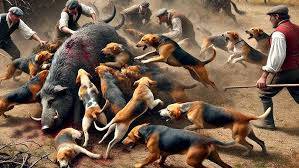Ways in Which Farmers and Hunters Use Wildlife for Hunting Wild Animals
Hunting wild animals has been a fundamental aspect of human survival for centuries, and while it remains a crucial part of many rural communities, it also plays a role in wildlife management and agricultural practices. Farmers and hunters often interact with wildlife in various ways, from using wildlife as a resource to controlling populations and ensuring the health of crops and livestock. There are several methods through which farmers and hunters engage with wild animals, including the use of tools, techniques, and traditional knowledge passed down through generations.
1. Use of Traps and Snares
Trapping is one of the oldest methods of capturing wild animals for food or population control. Farmers and hunters use a variety of traps to capture animals that pose a threat to crops or livestock. These can range from simple snares to more complex cage traps. Snares, often made from wire or cord, are designed to catch the animal by the neck or leg, while cage traps lure the animal into a confined space. Farmers may use these methods to catch predators like coyotes, raccoons, or foxes that threaten their livestock, while hunters use similar techniques to capture game for food.
2. Tracking and Stalking
Tracking and stalking involve carefully following the signs of animals, such as footprints, droppings, and disturbed vegetation, to locate and capture or kill the target. Farmers who face the issue of wild animals damaging crops may use tracking to monitor the movement of deer or wild boar that are eating their fields. By understanding the animals' routes and habits, they can either scare them away, set up barriers, or hunt them effectively. Stalking, on the other hand, requires patience and skill, as hunters need to get close enough to the animal without being noticed.
3. Hunting with Dogs
Dogs have been used in hunting for centuries due to their keen sense of smell, tracking abilities, and agility. Different breeds of dogs are trained for different types of hunting. For example, hounds are commonly used for tracking game like deer, boar, or rabbits, while terriers may be used to hunt smaller animals such as foxes or rodents. Farmers and hunters alike rely on dogs for both practical and sport purposes. Farmers may use dogs to help protect their livestock from predators like wolves or coyotes, while hunters use them to help track and flush out wild game.
4. Bow and Arrow
The use of bow and arrow for hunting is an ancient method that continues to be popular today, especially for game such as deer, elk, and even wild pigs. The bow allows hunters to quietly approach their prey and take a precise shot without making too much noise, which is particularly important in areas where wildlife is wary of human presence. For farmers, the bow and arrow may be used to control populations of animals that damage crops, such as deer or birds. This method requires a great deal of skill and patience, as hunters must learn to read animal behavior and anticipate their movements.
5. Use of Bait and Lures
Baiting is another common technique used by both hunters and farmers to attract wild animals. This can be especially effective for animals that are hard to locate or for hunters who want to attract a particular species. Hunters may use a variety of foods, scents, or pheromones to lure animals into a designated area. For example, sweet fruits or grains are often used to attract deer, while fish or meat can be used to draw in predators like wolves or bears. Farmers also use baiting techniques, particularly when dealing with pests like rodents, raccoons, or birds that threaten crops or stored food supplies.
6. Silent and Stealthy Approaches
Stealth is a crucial element in hunting, and many methods revolve around staying hidden from animals. Farmers and hunters often employ techniques that involve blending into the environment, using camouflage clothing, or setting up hunting blinds to remain undetected. This allows hunters to get close to their prey without alarming it, increasing the chances of a successful hunt. Farmers may use similar tactics to observe and control wildlife around their property. For example, they may watch for signs of deer or boar and then take action to either deter them with noise or take them down using a firearm or bow.
7. Firearms and Modern Technology
While traditional methods of hunting, like the use of traps, stalking, or the bow and arrow, are still widely used, modern technology has expanded the tools available to hunters and farmers. Firearms, including rifles and shotguns, are commonly used for hunting larger game, such as deer, wild boar, and even predators like coyotes. Thermal scopes, drones, and trail cameras are also becoming more popular, enabling hunters and farmers to track animal movement more efficiently and determine the best time and place to hunt.
8. Cooperative Hunting and Community Efforts
In some regions, farmers and hunters work together to manage local wildlife populations. Cooperative hunting efforts can be especially useful when it comes to controlling invasive species or reducing the number of animals that pose a risk to crops and livestock. In these cases, local governments or organizations may help organize hunts that allow farmers, hunters, and wildlife managers to control animal populations while ensuring the health of the ecosystem.
Conclusion
Farmers and hunters have developed a range of methods over the years to interact with wild animals, whether for sustenance, pest control, or conservation purposes. From traditional techniques like trapping and stalking to modern approaches like the use of firearms and technology, these practices are not only integral to human survival but also vital for maintaining ecological balance. By understanding wildlife behavior and using appropriate methods, farmers and hunters play a key role in the management and conservation of wild animals and their habitats.


